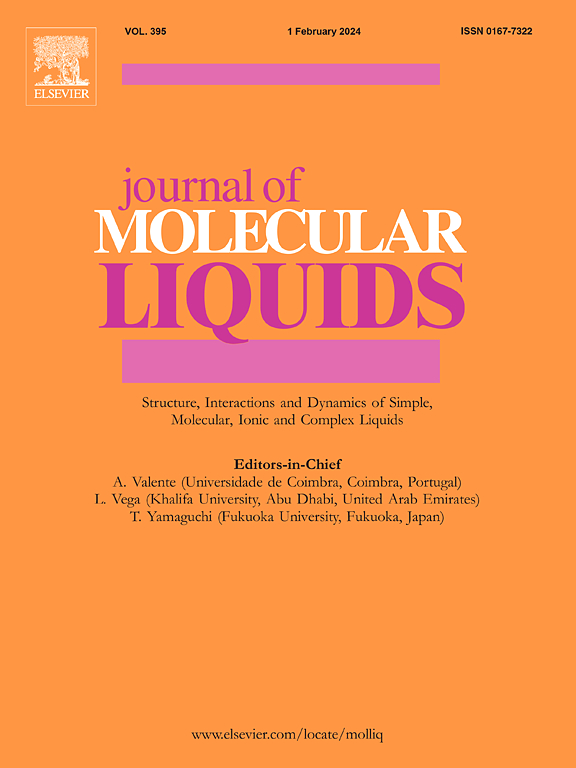含聚谷醛酸酯的雌激素化合物和水的相平衡:一个原子的研究
IF 5.3
2区 化学
Q2 CHEMISTRY, PHYSICAL
引用次数: 0
摘要
雌激素类化合物是由于人类活动而出现在废水中的一种新污染物,同时也是农业实践和生物医学治疗中必不可少的化学物质。这篇论文系统地研究了水、雌二醇、雌三醇、雌酮、炔雌二醇、己烯雌酚、美雌醇和孕酮与聚谷醛酸盐之间的相平衡和相关的分子间相互作用。gulurate是常见的多糖生物聚合物海藻酸盐的一个组成部分。采用分子动力学模拟方法研究聚古尔醛酸酯链的内聚能密度,采用随机分子模拟方法研究水或雌激素+古尔醛酸酯体系的混合能、配位数和自由能。然后结合随机原子模拟的结果,采用扩展的Flory-Huggins方法计算相平衡。本文提出的结果对这些新兴污染物与这种生物聚合物的分子水平行为有了深入的了解,这有助于未来与环境修复、污染物检测和药物释放相关的研究。本文章由计算机程序翻译,如有差异,请以英文原文为准。
Phase equilibria of estrogenic compounds and water with poly(guluronate): an atomistic study
Estrogenic compounds are an emerging contaminant in wastewater due to human activities, while also being essential chemicals in agricultural practices and biomedical therapies. This contribution presents a systematic investigation of the phase equilibria and associated intermolecular interactions between water, estradiol, estriol, estrone, ethinylestradiol, diethylstilbestrol, mestranol, and progesterone with poly(guluronate). Guluronate is a constituent of the common polysaccharide biopolymer alginate. Molecular dynamics simulations were used to study the cohesive energy density of poly(guluronate) chains, while stochastic molecular simulations were employed to study the mixing energy, coordination numbers, and free energy of water or estrogen + guluronate systems. Phase equilibria were then computed using an extended Flory-Huggins approach coupled with the results of the stochastic atomistic simulations. The results presented herein yield insights into the molecular-level behaviour of these emerging pollutants with this biopolymer, which can assist in future research related to environmental remediation, contaminant detection, and drug release.
求助全文
通过发布文献求助,成功后即可免费获取论文全文。
去求助
来源期刊

Journal of Molecular Liquids
化学-物理:原子、分子和化学物理
CiteScore
10.30
自引率
16.70%
发文量
2597
审稿时长
78 days
期刊介绍:
The journal includes papers in the following areas:
– Simple organic liquids and mixtures
– Ionic liquids
– Surfactant solutions (including micelles and vesicles) and liquid interfaces
– Colloidal solutions and nanoparticles
– Thermotropic and lyotropic liquid crystals
– Ferrofluids
– Water, aqueous solutions and other hydrogen-bonded liquids
– Lubricants, polymer solutions and melts
– Molten metals and salts
– Phase transitions and critical phenomena in liquids and confined fluids
– Self assembly in complex liquids.– Biomolecules in solution
The emphasis is on the molecular (or microscopic) understanding of particular liquids or liquid systems, especially concerning structure, dynamics and intermolecular forces. The experimental techniques used may include:
– Conventional spectroscopy (mid-IR and far-IR, Raman, NMR, etc.)
– Non-linear optics and time resolved spectroscopy (psec, fsec, asec, ISRS, etc.)
– Light scattering (Rayleigh, Brillouin, PCS, etc.)
– Dielectric relaxation
– X-ray and neutron scattering and diffraction.
Experimental studies, computer simulations (MD or MC) and analytical theory will be considered for publication; papers just reporting experimental results that do not contribute to the understanding of the fundamentals of molecular and ionic liquids will not be accepted. Only papers of a non-routine nature and advancing the field will be considered for publication.
 求助内容:
求助内容: 应助结果提醒方式:
应助结果提醒方式:


